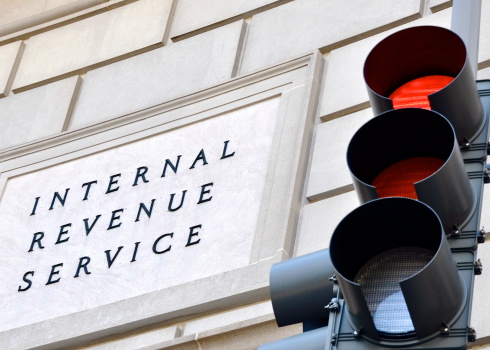
by admin | Dec 23, 2021 | IRS
 On November 4, 2021, the Internal Revenue Service (IRS) released Notice 2021-61 announcing cost-of-living adjustments affecting dollar limits for pension plans and other retirement-related items for tax year 2022. Many pension plan limits will change next year because the increase in the cost-of-living index met the statutory thresholds that trigger their adjustment. Other items, however, will not increase for 2022. Here is a summary of the limits for 2022.
On November 4, 2021, the Internal Revenue Service (IRS) released Notice 2021-61 announcing cost-of-living adjustments affecting dollar limits for pension plans and other retirement-related items for tax year 2022. Many pension plan limits will change next year because the increase in the cost-of-living index met the statutory thresholds that trigger their adjustment. Other items, however, will not increase for 2022. Here is a summary of the limits for 2022.
For 401(k), 403(b), and most 457 plans and the federal government’s Thrift Savings Plans:
- The elective deferral (contribution) limit increases from $19,500 for 2021 to $20,500 for 2022.
- The catch-up contribution limit for employees aged 50 and over who participate in these plans will stay the same at $6,500 for 2022.
For individual retirement arrangements (IRAs):
- The limit on annual contributions will not change for 2022. It remains $6,000.
- The additional catch-up contribution limit for individuals aged 50 and over is not subject to an annual cost-of-living adjustment so it remains $1,000 for 2022.
For simplified employee pension (SEP) IRAs and individual/solo 401(k) plans:
- Elective deferrals increase to $61,000 for 2022, based on an annual compensation limit of $305,000 (up from the 2021 amounts of $58,000 and $290,000).
- The minimum compensation that may be required for participation in a SEP remains unchanged at $650.
For savings incentive match plan for employees (SIMPLE) IRAs:
- The contribution limit on SIMPLE IRA retirement accounts increases from $13,500 for 2021 to $14,000 for 2022.
- The SIMPLE catch-up limit remains unchanged at $3,000 for 2022.
For defined benefit plans:
- The basic limitation on the annual benefits under a defined benefit plan increases from $230,000 for 2021 to $245,000 for 2022.
Other items:
- The threshold for determining “highly compensated employees” increases from $130,000 for 2021 to $135, 000 for 2022.
- The threshold for officers who are “key employees” in a top-heavy plan increases from $185,000 for 2021 to $200,000 for 2022.
- In a separate announcement, the Social Security Administration stated that the 2022 taxable wage base will increase to$147,000, an increase of $4,200 from the 2021 taxable wage base of $142,800. Thus, the maximum Social Security tax liability will increase for both employees and employers.
The IRS announcement is needed information for employers that sponsor 401(k) plans and other types of retirement and savings plans. For those interested in health and welfare plans, the IRS will release a separate announcement on the 2022 benefit limits for health flexible spending accounts (HFSAs) and transit benefit programs which we’ll cover separately on this blog.
By Kathleen A. Berger, CEBS
Originally posted on Mineral

by admin | Dec 15, 2021 | IRS
 The Internal Revenue Service (IRS) announced annual inflation adjustments for more than 50 tax provisions, including an increase in voluntary employee contributions to employer-sponsored healthcare flexible spending arrangements (HFSAs) to $2,850 for plan years beginning in 2022, up from the 2021 limit of $2,750.
The Internal Revenue Service (IRS) announced annual inflation adjustments for more than 50 tax provisions, including an increase in voluntary employee contributions to employer-sponsored healthcare flexible spending arrangements (HFSAs) to $2,850 for plan years beginning in 2022, up from the 2021 limit of $2,750.
For HFSAs that include a carryover provision, up to $570 may be carried over from the 2022 plan year to the next plan year. Note that HFSAs had the option of allowing an unlimited carryover for the 2021 plan year due to federal COVID-19 relief provisions. For unused HFSA funds at the end of the 2022 plan year, however, the plan cannot allow more than $570 to be carried over for use in the following year.
The IRS also announced an increase in the 2022 monthly limits for qualified transportation fringe benefits under Code § 132(f). For transportation in a commuter highway vehicle and mass transit passes, the limit will be $280 (up from $270 this year). The separate monthly limit for qualified parking also will increase to $280.
Details of this announcement can be found in Revenue Procedure 2021-45.
By Kathleen A. Berger, CEBS
Originally posted on Mineral

by admin | Sep 7, 2021 | Hot Topics, Human Resources, IRS
Employers, have you reminded your employees to check that they are having the right amount of tax withheld from their paychecks? It’s a good idea for everyone to check their payroll withholding every year, but it is particularly important this year due to the many proposed tax changes.
The law’s changes do not affect every taxpayer the same way. Some workers may need to increase their withholding so they will not face a tax bill —and possible penalties — next April when their 2021 tax return is due. Many other workers, however, benefit from the law’s changes and can take home more pay because the withholding amounts are less.
Help your employees avoid being surprised next spring when they prepare their 2021 returns. Remind them now to check their year-to-date withholding so they can make adjustments, if appropriate, on their paychecks for the rest of this year. It’s easy and convenient using tools provided by the IRS.
Here is a sample message to employees:
The IRS encourages everyone to use the Withholding Calculator to perform a quick “paycheck checkup.” This is even more important this year because of recent changes to the tax law for 2021.
The Calculator helps you identify your tax withholding to make sure you have the right amount of tax withheld from your paycheck at work. Use the Calculator to see if you should give your employer a new Form W-4, Employee’s Withholding Allowance Certificate, to adjust your income tax withholding going forward.
To get started, gather your most recent pay stubs and a copy of your last federal tax return (2020 Form 1040). You’ll use the information to estimate your 2021 income and taxes.
The Withholding Calculator does not ask you to provide sensitive personally-identifiable information like your name, Social Security number, address, or bank account numbers. The IRS does not save or record the information you enter on the Calculator.
Ready to start? Make sure Javascript is enabled and go to: Withholding Calculator
by Kathleen Berger
Originally posted on thinkhr.com

by Johnson and Dugan | Aug 6, 2021 | Benefit Plan Tips, Tricks and Traps, Employee Benefits, Hot Topics, Human Resources, IRS
 Many employees have the option to choose between their employer’s plan and another program where they meet the eligibility requirements (i.e., spouse’s, domestic partner’s, or parent’s plan). A Cash in Lieu of Benefits program, or cash-out option, offers an incentive for those employees to waive the employer coverage and instead enroll in the other plan. The incentive is in the form of a cash payment added to their paycheck. Properly implementing a Cash in Lieu of Benefits program is crucial, as unexpected tax consequences could occur otherwise.
Many employees have the option to choose between their employer’s plan and another program where they meet the eligibility requirements (i.e., spouse’s, domestic partner’s, or parent’s plan). A Cash in Lieu of Benefits program, or cash-out option, offers an incentive for those employees to waive the employer coverage and instead enroll in the other plan. The incentive is in the form of a cash payment added to their paycheck. Properly implementing a Cash in Lieu of Benefits program is crucial, as unexpected tax consequences could occur otherwise.
Overview
The Internal Revenue Service (IRS) requires a Section 125 plan be in place to be a qualified cash-out option. If the plan is not set up under an IRC Section 125 plan, the plan will be disqualified and employees who elect coverage under the health plan will be taxed on an amount equal to the amount of cash they could have received for waiving coverage.
The IRS has ruled that when an option is available to either elect the health plan, or to receive a cash-out incentive, then the premium payment to the insurance company becomes wages. The reasoning is that when an employer makes payments to the insurance company where the employee has the option of receiving those amounts as wages, the employee is merely assigning future income (cash compensation) for consideration (health insurance coverage). Therefore, the payment is treated as a substitute for the health insurance coverage. By setting up an IRC Section 125 plan, the employer is offering a choice between cash and certain excludable employer-provided benefits, without adverse tax implications.
Plan Set-up
There must be a Plan Document in place and nondiscrimination requirements must be followed, including annual nondiscrimination testing, in order to be a qualified Section 125 plan. To meet nondiscrimination rules, Cash in Lieu of Benefits must be offered to all employees equitably. To be sure an employer is not over incentivizing employees to drop the plan, which could impact the nondiscrimination participation requirements, the monthly cash benefit should not exceed $200-$300.
When a Section 125 plan already exists (Premium Payment Plan, Health Care Spending Account, Dependent Care Spending Account), the plan can be amended to add the cash out feature. Where no Section 125 plan is in place, it is standard to have an attorney provide this service. It is important to note that, although the Section 125 plan protects the employees electing coverage from taxation, the cash-out incentive is an after-tax benefit.
As always with any IRS-qualified plan, proper documentation is essential. An employee should only be allowed to waive coverage when there is another plan available, and proof of enrollment is provided. If there is a subsequent loss of that coverage, HIPAA Special Enrollment Rights will allow entry onto the plan, and the cash-out incentive will cease.
Considerations
Cash in Lieu of Benefits funds cannot be used to purchase individual health coverage. For companies over 20 lives and Medicare is secondary coverage, the plan should not be structured to incentivize employees over 65 to opt out of the employer plan to enroll in Medicare.
Another factor to consider is the impact to employers considered Applicable Large Employers (ALE) and subject to the affordability determination and reporting under the Affordable Care Act (ACA). An ALE is an employer averaging 50 or more full-time plus full-time equivalent employees for the preceding 12 months. If a cash out option is offered without an IRS qualified Cash in Lieu of Benefits plan, the payment must be included in the affordability calculation.
There are also Fair Labor Standards Act (FLSA) implications. Any opt-out payments made by an employer to an employee must be included in an employee’s regular rate of pay and therefore is used in calculating overtime compensation for non-exempt employees.
These considerations should be reviewed with a tax expert and/or ERISA attorney to determine if a Cash in Lieu of Benefits program is the right option for your organization. These professionals, along with a Section 125 Plan Administrator, can provide the necessary guidance to ensure the program will satisfy compliance requirements. For further information on this topic, please contact your Johnson & Dugan team.
By Jody Lee, Johnson & Dugan

by admin | Jul 14, 2021 | Financial Planning, IRS
 WASHINGTON — The Internal Revenue Service today launched two new online tools designed to help families manage and monitor the advance monthly payments of Child Tax Credits under the American Rescue Plan. These two new tools are in addition to the Non-filer Sign-up Tool, announced last week, which helps families not normally required to file an income tax return to quickly register for the Child Tax Credit.
WASHINGTON — The Internal Revenue Service today launched two new online tools designed to help families manage and monitor the advance monthly payments of Child Tax Credits under the American Rescue Plan. These two new tools are in addition to the Non-filer Sign-up Tool, announced last week, which helps families not normally required to file an income tax return to quickly register for the Child Tax Credit.
The new Child Tax Credit Eligibility Assistant allows families to answer a series of questions to quickly determine whether they qualify for the advance credit.
The Child Tax Credit Update Portal allows families to verify their eligibility for the payments and if they choose to, unenroll, or opt out from receiving the monthly payments so they can receive a lump sum when they file their tax return next year. This secure, password-protected tool is available to any eligible family with internet access and a smart phone or computer. Future versions of the tool planned in the summer and fall will allow people to view their payment history, adjust bank account information or mailing addresses and other features. A Spanish version is also planned.
Both the Child Tax Credit Eligibility Assistant and Child Tax Credit Update Portal are available now on IRS.gov.
The American Rescue plan increased the maximum Child Tax Credit amount in 2021 to $3,600 per child for children under the age of 6 and to $3,000 per child for children ages 6 through 17. The advance Child Tax Credit payments, which will generally be made on the 15th of each month, create financial certainty for families to plan their budgets. Eligible families will receive a payment of up to $300 per month for each child under age 6, and up to $250 per month for each child ages 6 through 17. The first monthly payment of the expanded and newly-advanceable Child Tax Credit will be made on July 15. Most families will begin receiving monthly payments automatically next month without any further action required.
“IRS employees continue to work hard to help people receive this important credit,” IRS Commissioner Chuck Rettig said. “The Update Portal is a key piece among the three new tools now available on IRS.gov to help families understand, register for and monitor these payments. We will be working across the nation with partner groups to share information and help eligible people receive the advance payments.”
More features coming to the Update Portal soon
Coming soon, families will be able to use the Child Tax Credit Update Portal to check the status of their payments. In late June, people will be able to update their bank account information for payments starting in August. In early August, a feature is planned that will allow people to update their mailing address. Then, in future updates planned for this summer and fall, they will be able to use this tool for things like updating family status and changes in income.
For more information see the FAQs, which will continue to be updated.
Update Portal allows people to unenroll
Instead of receiving these advance payments, some families may prefer to wait until the end of the year and receive the entire credit as a refund when they file their 2021 return. In this first release of the tool, the Child Tax Credit Update Portal now enables these families to quickly and easily unenroll from receiving monthly payments.
The unenroll feature can also be helpful to any family that no longer qualifies for the Child Tax Credit or believes they will not qualify when they file their 2021 return. This could happen if, for example:
- Their income in 2021 is too high to qualify them for the credit.
- Someone else (an ex-spouse or another family member, for example) qualifies to claim their child or children as dependents in 2021.
- Their main home was outside of the United States for more than half of 2021.
Accessing the Update Portal
To access the Child Tax Credit Update Portal, a person must first verify their identity. If a person has an existing IRS username or an ID.me account with a verified identity, they can use those accounts to easily sign in. People without an existing account will be asked to verify their identity with a form of photo identification using ID.me, a trusted third party for the IRS. Identity verification is an important safeguard and will protect your account from identity theft.
Anyone who lacks internet access or otherwise cannot use the online tool may unenroll by contacting the IRS at the phone number included in your outreach letter.
Who is getting a monthly payment
In general, monthly payments will go to eligible families who:
- Filed either a 2019 or 2020 federal income tax return.
- Used the Non-Filers tool on IRS.gov in 2020 to register for an Economic Impact Payment.
- Registered for the advance Child Tax Credit this year using the new Non-Filer Sign-up Tool on IRS.gov.
An eligible family who took any of these steps does not need to do anything else to get their payments.
Normally, the IRS will calculate the advance payment based on the 2020 income tax return. If that return is not available, either because it has not yet been filed or it has not yet been processed, the IRS is instead determining the payment using the 2019 tax return.
Eligible families will receive advance payments, either by direct deposit or check. Each payment will be up to $300 per month for each child under age 6 and up to $250 per month for each child ages 6 through 17. The IRS will issue advance Child Tax Credit payments on these dates: July 15, August 13, September 15, October 15, November 15 and December 15.
The IRS urges any family who hasn’t yet filed their 2020 return – or 2019 return – to do so as soon as possible so they can receive any advance payment they’re eligible for. At the same time, the agency cautions that tax returns must be processed by June 28 to be reflected in the first batch of monthly payments scheduled for July 15, so eligible families filing now will likely receive payments in the following months. Even if monthly payments begin after July, the IRS will adjust the monthly amounts upward to ensure that people still receive half of their total eligible Child Tax Credit benefit by the end of the year.
Filing soon will also ensure that the IRS has their most current bank account information, as well as key details about qualifying family members. This includes people who don’t normally file a tax return, such as families experiencing homelessness and people in underserved groups.
For most people, the fastest and easiest way to file a return is by using IRS Free File, available only on IRS.gov. Besides qualifying them for these advance payments, using Free File will also enable them to claim other family-oriented tax benefits, if eligible, such as the Earned Income Tax Credit and the Recovery Rebate Credit/Economic Impact Payments.
New tool helps non-filers register
For families who don’t normally file an income tax return, another easy option is to register for these advance payments using the new Non-filer Sign-up Tool, introduced recently, and available only on IRS.gov. Among other things, the tool asks users to supply current bank information, along with key details about themselves and their qualifying children. The tool then automatically fills in a very basic 2020 federal income tax return that is electronically sent to the IRS. The new tool was developed in partnership with Intuit and the Free File Alliance.
Child Tax Credit Eligibility Assistant unveiled
Before filing a return or using the Non-filer Sign-up Tool, families unsure of whether they qualify for either the credit or the advance payments may want to check out another new tool — the Child Tax Credit Eligibility Assistant. By answering a series of questions, the tool helps people determine if they qualify for the credit and the payments.
The IRS emphasized that because the Child Tax Credit Eligibility Assistant requests no personalized information, it is not a registration tool, but merely an eligibility tool. Nevertheless, it can still help an eligible family determine whether they should take the next step and either file an income tax return or register using the Non-filer Sign-up Tool.
Personal help available
IRS and its partners are helping families register for the payments using the Non-filer Sign-up Tool. During late June and early July, free events will take place in Atlanta, Brooklyn, Detroit, Houston, Las Vegas, Los Angeles, Miami, Milwaukee, Philadelphia, Phoenix, St. Louis and Washington, D.C. More details will be available soon on IRS.gov.
Child Tax Credit 2021
The IRS has created a special Advance Child Tax Credit 2021 page, designed to provide the most up-to-date information about the credit and the advance payments. It’s at IRS.gov/childtaxcredit2021.
Among other things, it provides direct links to the Non-Filer Sign Up Tool, the Child Tax Credit Update Portal, the Child Tax Credit Eligibility Assistant, a set of frequently asked questions and other useful resources.
Child Tax Credit changes
The American Rescue Plan raised the maximum Child Tax Credit in 2021 to $3,600 for children under the age of 6 and to $3,000 per child for children ages 6 through 17. Before 2021, the credit was worth up to $2,000 per eligible child.
The new maximum credit is available to taxpayers with a modified adjusted gross income (AGI) of:
- $75,000 or less for singles,
- $112,500 or less for heads of household and
- $150,000 or less for married couples filing a joint return and qualified widows and widowers.
For most people, modified AGI is the amount shown on Line 11 of their 2020 Form 1040 or 1040-SR. Above these income thresholds, the extra amount above the original $2,000 credit — either $1,000 or $1,600 per child — is reduced by $50 for every $1,000 in modified AGI. In addition, the credit is fully refundable for 2021. This means that eligible families can get it, even if they owe no federal income tax. Before this year, the refundable portion was limited to $1,400 per child.
Help spread the word
The IRS urges community groups, non-profits, associations, education organizations and anyone else with connections to people with children to share this critical information about the Child Tax Credit as well as other important benefits. Among other things, the IRS is already working closely with its community partners to ensure wide access to the Non-filer Sign-up Tool and the Child Tax Credit Update Portal. The agency is also providing additional materials and information that can be easily shared by social media, email and other methods.
For the most up-to-date information on the Child Tax Credit and advance payments, visit Advance Child Tax Credit Payments in 2021.
Originally posted on IRS.gov
by admin | Jun 13, 2019 | Human Resources, IRS
Question: Are amounts an employer reimburses employees for mileage taxable?
Answer: They may be; the type of reimbursement plan will dictate whether reimbursement for business travel is or is not taxable. Both accountable plans and non-accountable plans allow an employer to reimburse employees for their business expenses.
With an accountable plan, the reimbursement is not taxable to your employee. Amounts paid under an accountable plan are not wages and are not subject to income tax withholding and payment of Social Security, Medicare, and Federal Unemployment Tax Act (FUTA) taxes. Your reimbursement or allowance arrangement must meet all of the following conditions in order to quality as an accountable plan:
- There must be a business connection to the expenditure. This means that the expense must be a deductible business expense incurred in connection with services performed as an employee of the employer. If not reimbursed by the employer, the expense may be deductible by the employee from their taxable income.
- There must be adequate accounting by the employee. This means that the employee must give their employer a statement of expense, an account book, a diary, or a similar record in which they entered each use at or near the time it occurred, along with date, mileage, and the business purpose of the use.
- Excess reimbursements or advances must be returned within a reasonable period of time.
A non-accountable plan does not meet the three requirements for accountable plans and is subject to all employment taxes and withholding. Payments under a non-accountable plan occur if: (1) the employee is not required to substantiate expenses with receipts or other documentation in a timely manner; and (2) the employer advances an amount to the employee for business expenses and the employee is not required to, and does not, return any amount he or she does not use for business expenses in a timely manner.
Employers should also check with their state department of taxation to understand any state tax rules applicable to them.
For more detailed information on federal mileage reimbursement, see the IRS page containing Publication 463, Travel, Entertainment, Gift, and Car Expenses, and updates to this publication since its publication date.
Originally posted on ThinkHR.com

 On November 4, 2021, the Internal Revenue Service (IRS) released Notice 2021-61 announcing cost-of-living adjustments affecting dollar limits for pension plans and other retirement-related items for tax year 2022. Many pension plan limits will change next year because the increase in the cost-of-living index met the statutory thresholds that trigger their adjustment. Other items, however, will not increase for 2022. Here is a summary of the limits for 2022.
On November 4, 2021, the Internal Revenue Service (IRS) released Notice 2021-61 announcing cost-of-living adjustments affecting dollar limits for pension plans and other retirement-related items for tax year 2022. Many pension plan limits will change next year because the increase in the cost-of-living index met the statutory thresholds that trigger their adjustment. Other items, however, will not increase for 2022. Here is a summary of the limits for 2022.





 WASHINGTON — The Internal Revenue Service today launched two new online tools designed to help families manage and monitor the advance monthly payments of Child Tax Credits under the American Rescue Plan. These two new tools are in addition to the Non-filer Sign-up Tool, announced last week, which helps families not normally required to file an income tax return to quickly register for the Child Tax Credit.
WASHINGTON — The Internal Revenue Service today launched two new online tools designed to help families manage and monitor the advance monthly payments of Child Tax Credits under the American Rescue Plan. These two new tools are in addition to the Non-filer Sign-up Tool, announced last week, which helps families not normally required to file an income tax return to quickly register for the Child Tax Credit.